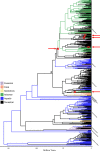Macroevolution of arboreality in salamanders
- PMID: 31380029
- PMCID: PMC6662381
- DOI: 10.1002/ece3.5267
Macroevolution of arboreality in salamanders
Abstract
Evolutionary theory predicts that selection in distinct microhabitats generates correlations between morphological and ecological traits, and may increase both phenotypic and taxonomic diversity. However, some microhabitats exert unique selective pressures that act as a restraining force on macroevolutionary patterns of diversification. In this study, we use phylogenetic comparative methods to investigate the evolutionary outcomes of inhabiting the arboreal microhabitat in salamanders. We find that arboreality has independently evolved at least five times in Caudata and has arisen primarily from terrestrial ancestors. However, the rate of transition from arboreality back to terrestriality is 24 times higher than the converse. This suggests that macroevolutionary trends in microhabitat use tend toward terrestriality over arboreality, which influences the extent to which use of the arboreal microhabitat proliferates. Morphologically, we find no evidence for an arboreal phenotype in overall body proportions or in foot shape, as variation in both traits overlaps broadly with species that utilize different microhabitats. However, both body shape and foot shape display reduced rates of phenotypic evolution in arboreal taxa, and evidence of morphological convergence among arboreal lineages is observed. Taken together, these patterns suggest that arboreality has played a unique role in the evolution of this family, providing neither an evolutionary opportunity, nor an evolutionary dead end.
Keywords: amphibian; macroevolution; microhabitat; phylogenetic comparative methods.
Conflict of interest statement
None declared.
Figures





References
-
- Adams, D. C. , & Collyer, M. L. (2018). Phylogenetic ANOVA: Group‐clade aggregation, biological challenges, and a refined permutation procedure. Evolution, 72, 1204–1215. - PubMed
-
- Adams, D. C. , Collyer, M. L. , & Kaliontzopoulou, A. (2018). Geomorph: Software for geometric morphometric analyses. R package version 3.0.7. Retrieved from https://cran.r-project.org/package=geomorph
Associated data
LinkOut - more resources
Full Text Sources
Other Literature Sources

